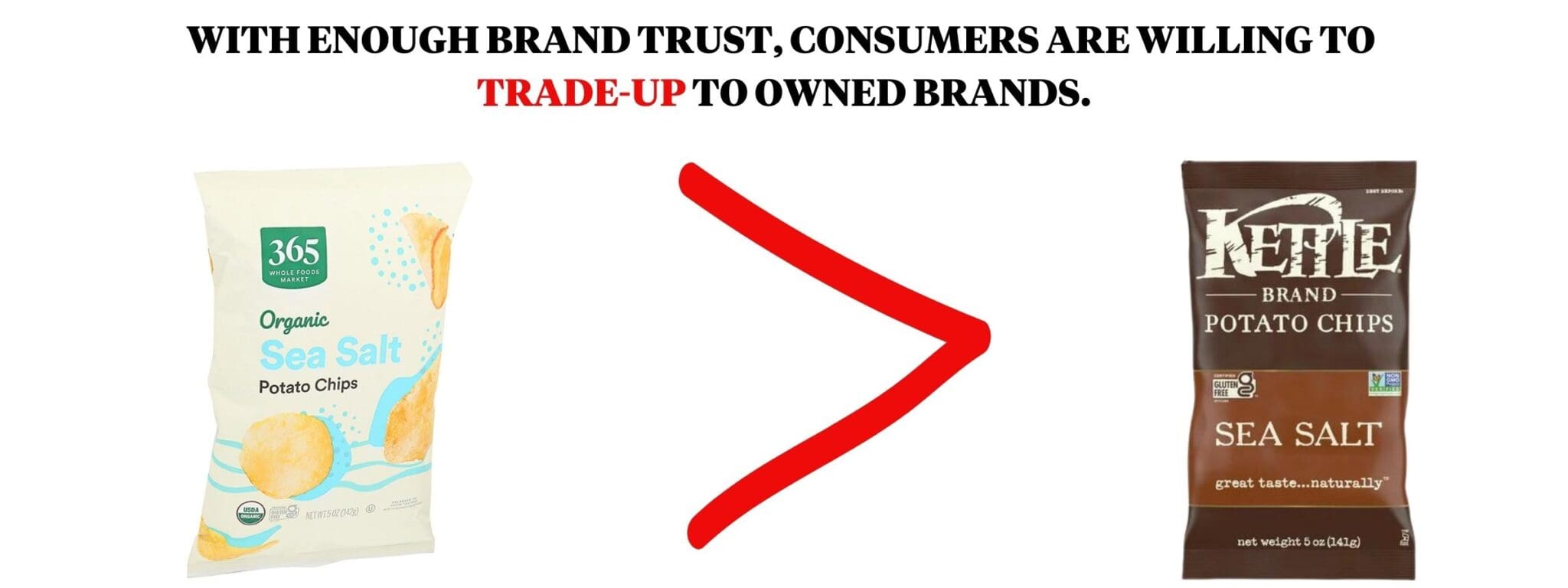Retailers are relentless when seeking to improve gross margins and customer loyalty, and private-label can “potentially” move both data points in a positive direction. As such, the battle between branded vs. private-label is an ongoing fight, but recent changes in the economic climate are intensifying the situation.
Across many CPG categories, consumers are looking for cost-saving and premium private-label products as replacements for their current choice. And retailers are taking notice, optimizing their existing private-label brands for better performance, and creating new category offerings.
This article will discuss the current climate of private-label, providing insights into how to enter (and compete) in this private-label world. You will understand the factors driving consumers to choose a private brand over a branded product. We will discuss what a national brand can do to ensure they remain on the shelf.
- Why own-label brands are increasing in popularity.
- The challenges that private label brands face.
- How house brands can compete against category leaders.
- How branded products can compete against emerging private brands.
- Our thoughts on what the future of this war looks like.
Private-Label Brands Are on the Rise
The data doesn’t lie. Private-label brands continue to be popular choices for cost-conscious consumers. We’ve seen sales increases across multiple categories, and retailers responded by expanding their private-label offerings. Here are some of the most important statistics regarding private-label products.
Consumers seeking a great value: A Deloitte survey determined that 65% of consumers are willing to switch to a white-label brand if they deem their current price is too high. Inflation is making this a reality across many categories.
Consumers are increasing their private-label spending while saving money: Aligning with the previous survey, McKinsey reports how people are spending more on private-label. The dominant reason being equal quality for a lesser cost.
More consumers choose the private-label brand: PLMA reports that store brand sales rose 11.3% in 2022. With such a growing market share, private-label SKUs are no longer competing against branded products but against other retailers who make white labeling a priority.
Private-label growth impacts specific consumers more than others: While the median private-label purchase volume is higher in the international markets, specific CPG categories and consumer demographics in the US are experiencing significant private-label growth. Two interesting statistics from Stylus are how millennials have adapted to PL products with a 45% purchase rate. Bakery products leading at a 40% year-over-year growth rate.
Here’s what the research has yet to show but is apparent when shopping in stores. Consumers are trading-up to private-label products. An example is a consumer switching from name-brand potato chips to an organic private-label competitor. With retailers investing more in their private-label go-to-market strategy, we expect this trend to continue in the coming years.

Challenges Facing Private-Label Brands
The immediate challenge for retailers heavily investing in private-label products is adapting to change. While immediate positioning and internal promotion are easy to implement, there continues to be friction between focusing on private-label and focusing on their promotion of branded products. This holds true during bottom markets and when retailers do not run their private-label products as separate divisions within the company.
Any time ingredient costs rise or supply chain issues appear, retailers return to the CPG strategy room, weighing the pros and cons of their current private-label lineup. However, private-label brands can create a wider pricing spread during inflationary periods since their products have gross margins that exceed their branded competitors.
Private-label manufacturing is also a pain point for retailers. Retailers don’t always have the right resources for supply chain checks and balances. One example is how private-label brands need a secondary manufacturer (or several) ready if their current partner is no longer the right fit.
Out-of-stock private-label SKUs give branded products that are foaming at the mouth. They will immediately capitalize on this opportunity, winning consumers back with their heavy branding and advertising campaigns.
How Private-Label Brands Can Compete
We are getting more calls from private-label brands than ever before, which isn’t because of any specific marketing campaign we’ve developed. The reason is that retailers think of their private-label products as more than a store brand; they recognize the importance of driving brand awareness before and in-real time when consumers see their products on retail shelves. They also understand the need to drive greater purchase intent using the proper packaging, design, and messaging.
Our experience with successful private-label brands has shown two principal ways they are stepping up to be more competitive with national brands.
Brand Management Team

Through an internal team, engaging with an agency, or combining both, successful house brands no longer leave product decisions to a single designer and decision-maker. Now, to compete with national brands, retailers are creating an A-Z strategy covering everything you would find in full-fledged brand development.
Shelf Performance Testing

Previously, retailers would put their products on the shelf and decide based on feedback and reports. Now, with heavier investments and greater revenue potential than ever before, white-label offerings go through rigorous consumer testing to determine the impact of their shelf impact in advance. They no longer want to play nice with brand-name products; instead, they seek to become the category leader, letting national CPG brands fight for scraps.
Private-Label Brands and CPG Trends
No longer about price savings, store brands need to consider and test packaging design trends such as sustainability for their house products. Since consumers are increasingly interested in sustainably made products, not considering this in your product packaging may lead to consumer detraction.
Not all trends apply to your brand. Going against a trend may be a way to stand out with your retail packaging and speak to a specific audience. Package design testing is how you validate each trend’s impact on consumer impact.
How Branded Products Can Compete
Just because a retailer replicates a product within a category doesn’t mean it’s the death of your brand. Consider Tylenol vs. its generic competitors. There is a noticeable price saving with white-label over-the-counter drugs, yet Johnson & Johnson is still piling up profits with this SKU.
National brands that earn trust earn brand loyalty. If your head is pounding hard enough, you will not take the chance on a less established product in the marketplace. Here’s how you capture consumer confidence through branding and product development.
Own Your Space

How concerned is liquid death about a retailer partner who now offers private-label water in a can? Not very.
Owning your space means establishing so much brand equity with your chosen audience that customer loyalty must occur. Even though a retailer may have thousands of stores, they are unlikely to go this narrow with brand personalization. Omnichannel brands can get dangerously specific (nearly to liquid death!) and still see exponential growth, eventually becoming accepted by the mainstream consumer.
Drive Innovation

Branded products can create a more solidified, nearly impenetrable foothold in the market when they lead to innovation. Through patented ingredients, influencer partnerships, brand collaborations, and other means of innovating your position in the marketplace, branded products make it extremely difficult to steal away their market share.
Have a Better Brand Story

The level at which a national brand can compete in this private-label world depends on its brand story. Consumers make purchasing decisions based on their relationship with a brand, and your story is how you attract consumers. A compelling story about your product’s mission and values creates an emotional connection with consumers.
In today’s economy, many consumers are trading down to own-brands that cost less as they seek to save money at the grocery store. Unless you want to start losing more to owned brands, a brand owner must consider how their product shows up in retail. – Kevin Smith, Founder of SmashBrand
How Will This War Play Out?
The war between private-label and branded products will never cease to exist. Both sides will win single-battles, but as new channels emerge and marketing mediums develop, branded products will continue to drive innovation in the marketplace.
Retailers will continue to have “friendly tension” with their brand partners, often working to collaborate before taking them head-on. In any case, branded and private-label products will need expertise, insights, and testing to enter the retail arena with their own product.
Data-Driven Brand Development For CPG Brands
Want a best-selling brand? SmashBrand is a brand development agency that takes a data-first approach. Whether you are a brand name or developing a private-label line, we can help you capture market share on retail shelves.
Book a time to discuss your project with our team.
Subscribe to
Nice Package.
A monthly newsletter that unpacks a critical topic in the FMCG & CPG industry.
Free Resource.

CPG product repositioning guide.
Explore the five undeniable signs your CPG product needs repositioning along with strategies for leveraging consumer insights for a guaranteed market lift.
Learn More About CPG product repositioning guide.